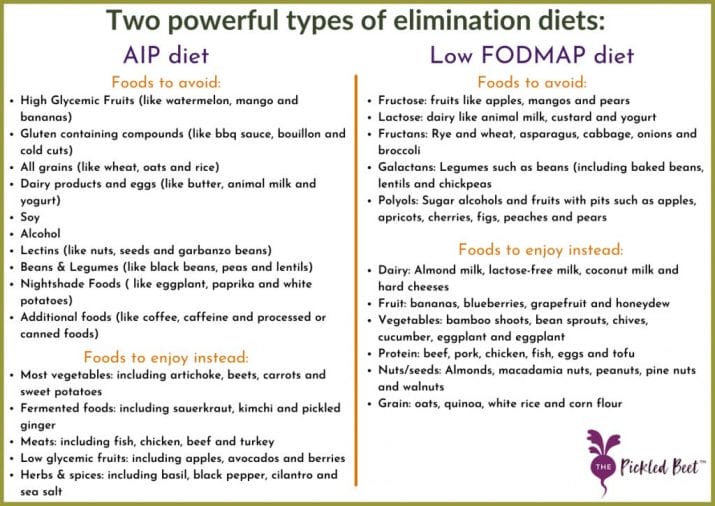March 1 kicks off the beginning of Autoimmune Awareness Month, which covers many different diagnoses from multiple sclerosis to lupus to diabetes and much, much more.
At The Pickled Beet, we operate under the philosophy that food is medicine. Many of our clients choose our personal chef services because they know that we don’t just cook food to be tasty or even generically “healthy.” Some of our clients have some pretty serious health scenarios they need help tackling. And dealing with autoimmune disorders is one of them.
So how do we approach this with our clients? Well, first we have to sort out which foods are causing them more harm than good. And one way to do this is by conducting an elimination diet.

What’s The Point Of An Elimination Diet And Should I Try It?
An elimination diet helps you identify which foods might be creating inflammation or damaging your gut, which compromises your overall health.
The best way to identify your food triggers or intolerances is to remove the most common offenders. You have to give your body a chance to break the cycle of constantly reacting to foods you’re sensitive to. By creating a baseline of normalcy and calm, you can better know when a food you have added back in is causing an adverse reaction.
It is important to note the difference between a food sensitivity and a food allergy. Food sensitivities can cause symptoms like bloating, migraines, joint pain, rashes–things that, over the long run, won’t kill you but can become quite a bother. And the reactions they cause in your body can, over time, even develop into an autoimmune disorder you never had in the first place!

On the other hand, food allergies can be life-threatening stuff–you know the sort of thing. We’re looking at you, peanut allergies. (Want to learn more about this topic? Check out this explanation from the Mayo Clinic!)
But wait… what about food sensitivity testing? Does it work? Can’t I just do that instead?
Food sensitivity testing can be a very powerful tool in helping you narrow down ingredients to remove as you begin your elimination diet!
An important caveat to testing is that unless you have eaten the offending food before your test, you will not have the antibodies for it present in your bloodstream, so it may appear that you do not have an issue with that food. This is an often misunderstood fact about testing.
So yes, you can learn a lot about your food allergies, intolerances, and sensitivities from a test. But there is a difference between theory and practice, right? One powerful way to sort out what’s irritating your system is to go deep with investigating the food you eat.
That’s where an elimination diet comes in.
How does a food elimination diet plan work when working with a personal chef vs. doing it on your own?
Preparing meals that conform to an elimination diet can be an arduous task if you aren’t experienced. It’s incredibly time consuming to research and read food labels and figure out what substitutions are allowed and which aren’t.
Often, clients who have tried to navigate this difficult diet on their own contact us confused and frustrated.
But it doesn’t have to be that way. Here’s how we get you through the gauntlet and back to loving what you eat.
Two powerful types of elimination diets
Eliminate several “suspect” foods.
When we are working with clients on an elimination diet, we remove the most common problem foods from their meals. Ingredients that commonly cause inflammation include gluten, dairy, legumes, eggs, nightshades (that’s right, those eggplants and tomatoes might be giving you stomach aches!).

We remove these foods from your diet for a minimum of 30 days. Once those 30 days are over, the hope is that your body has gone through a bit of a reset. Now, it is time to begin the reintroduction phase: introducing those foods that are common troublemakers back into your diet one at a time.
As we do this, you’ll take note of how your body responds. We ask you to keep a careful food journal of any symptoms you’re experiencing during that time. If your symptoms start to reappear or if you experience an adverse reaction, then bingo! We’ve found the culprits.
And when it comes to autoimmune disorders, the last thing you need is food that irritates your body instead of nourishing it. Now that you know what is causing the problem, you can avoid it even when eating out.
A FODMAP elimination diet.
A low FODMAP diet(FODMAP stands for fermentable oligosaccharides, disaccharides, monosaccharides, and polyols)is a different kind of elimination diet; designed to help those struggling with Irritable Bowel Syndrome (IBS) in particular. Low FODMAP foods tend to be easier on digestive systems because they lack certain sugars.

The main difference between a FODMAP elimination diet and a general elimination diet plan lies in the list of foods that get eliminated upfront. You might be surprised at what foods are high in FODMAPs!
Like the autoimmune elimination diet, we cut out dairy and wheat products. But other vegetables such as asparagus, onions, and garlic are also off the table. Even honey, and some fruits such as apples and peaches are also cut out!
But here’s the good news. Sometimes it turns out you CAN eat high FODMAP foods. That’s the beauty of an elimination diet! It gives you a starting point of foods that could be a trigger for your digestive system and then allows you to figure out what is and isn’t working.
An Elimination Diet That Feels Good and Tastes Good

Eliminating food from your diet might not sound like much fun. But the adage is true. There is power in knowledge. And the truth is, an elimination diet doesn’t have to be a harrowing experience. In the hands of a trained chef that knows how to cook tasty foods with a limited amount of ingredients, you might not even notice you are missing anything at all.
Enjoy food that is both imaginative and healthy with The Pickled Beet’s personal chef services. Complete this food questionnaire to set up your free consultation and get started!
Disclaimer: We are not medical professionals, and the information we have provided is solely for educational purposes and is not intended to be medical advice, diagnosis, or treatment. Consult a healthcare professional to address any concerns or questions you may have regarding your diet or overall health. The Pickled Beet is not liable for any risks or issues associated with acting upon the information we have provided.


